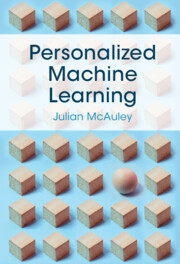Refine search
Actions for selected content:
3312 results in Artificial Intelligence and Natural Language Processing

Personalized Machine Learning
-
- Published online:
- 20 January 2022
- Print publication:
- 03 February 2022
Gamified crowdsourcing for idiom corpora construction
-
- Journal:
- Natural Language Engineering / Volume 29 / Issue 4 / July 2023
- Published online by Cambridge University Press:
- 20 January 2022, pp. 909-941
-
- Article
-
- You have access
- Open access
- HTML
- Export citation
Statistics in Corpus Linguistics: A New Approach by Sean Wallis. New York/Oxon: Routledge, 2021. ISBN 9781138589384 (PB: 44.95), ISBN 9781138589377 (HB: 160.00), ISBN 9780429491696 (eBook: 44.95), xxvi+382 pages.
-
- Journal:
- Natural Language Engineering / Volume 29 / Issue 1 / January 2023
- Published online by Cambridge University Press:
- 20 January 2022, pp. 177-180
-
- Article
- Export citation
A survey of the extraction and applications of causal relations
-
- Journal:
- Natural Language Engineering / Volume 28 / Issue 3 / May 2022
- Published online by Cambridge University Press:
- 20 January 2022, pp. 361-400
-
- Article
- Export citation
Joint learning of morphology and syntax with cross-level contextual information flow
-
- Journal:
- Natural Language Engineering / Volume 28 / Issue 6 / November 2022
- Published online by Cambridge University Press:
- 20 January 2022, pp. 763-795
-
- Article
-
- You have access
- Open access
- HTML
- Export citation
Authorship attribution using author profiling classifiers
-
- Journal:
- Natural Language Engineering / Volume 29 / Issue 1 / January 2023
- Published online by Cambridge University Press:
- 19 January 2022, pp. 110-137
-
- Article
- Export citation
UNLT: Urdu Natural Language Toolkit
-
- Journal:
- Natural Language Engineering / Volume 29 / Issue 4 / July 2023
- Published online by Cambridge University Press:
- 19 January 2022, pp. 942-977
-
- Article
-
- You have access
- Open access
- HTML
- Export citation
A Survey on Machine Reading Comprehension Systems
-
- Journal:
- Natural Language Engineering / Volume 28 / Issue 6 / November 2022
- Published online by Cambridge University Press:
- 19 January 2022, pp. 683-732
-
- Article
- Export citation
An analysis of property inference methods
-
- Journal:
- Natural Language Engineering / Volume 29 / Issue 2 / March 2023
- Published online by Cambridge University Press:
- 14 January 2022, pp. 201-227
-
- Article
- Export citation
$NLP: How to spend a billion dollars
-
- Journal:
- Natural Language Engineering / Volume 28 / Issue 1 / January 2022
- Published online by Cambridge University Press:
- 11 January 2022, pp. 125-136
-
- Article
-
- You have access
- Open access
- HTML
- Export citation
NLE volume 28 issue 1 Cover and Front matter
-
- Journal:
- Natural Language Engineering / Volume 28 / Issue 1 / January 2022
- Published online by Cambridge University Press:
- 11 January 2022, pp. f1-f2
-
- Article
-
- You have access
- Export citation
NLE volume 28 issue 1 Cover and Back matter
-
- Journal:
- Natural Language Engineering / Volume 28 / Issue 1 / January 2022
- Published online by Cambridge University Press:
- 11 January 2022, pp. b1-b2
-
- Article
-
- You have access
- Export citation
List of Contributors
-
- Book:
- Computational Analysis of Storylines
- Published online:
- 06 November 2021
- Print publication:
- 25 November 2021, pp xi-xiv
-
- Chapter
- Export citation
3 - Decomposing Events and Storylines
- from Part One - Foundational Components of Storylines
-
- Book:
- Computational Analysis of Storylines
- Published online:
- 06 November 2021
- Print publication:
- 25 November 2021, pp 67-86
-
- Chapter
- Export citation
1 - The Role of Event-Based Representations and Reasoning in Language
- from Part One - Foundational Components of Storylines
-
- Book:
- Computational Analysis of Storylines
- Published online:
- 06 November 2021
- Print publication:
- 25 November 2021, pp 23-46
-
- Chapter
- Export citation
Part One - Foundational Components of Storylines
-
- Book:
- Computational Analysis of Storylines
- Published online:
- 06 November 2021
- Print publication:
- 25 November 2021, pp 21-22
-
- Chapter
- Export citation
4 - Extracting and Aligning Timelines
- from Part One - Foundational Components of Storylines
-
- Book:
- Computational Analysis of Storylines
- Published online:
- 06 November 2021
- Print publication:
- 25 November 2021, pp 87-105
-
- Chapter
- Export citation
8 - Low-Resource Event Extraction via Share-and-Transfer and Remaining Challenges
- from Part Two - Connecting the Dots: Resources, Tools, and Representations
-
- Book:
- Computational Analysis of Storylines
- Published online:
- 06 November 2021
- Print publication:
- 25 November 2021, pp 163-186
-
- Chapter
- Export citation
11 - Exploring Machine Learning Techniques for Linking Event Templates
- from Part Two - Connecting the Dots: Resources, Tools, and Representations
-
- Book:
- Computational Analysis of Storylines
- Published online:
- 06 November 2021
- Print publication:
- 25 November 2021, pp 221-239
-
- Chapter
- Export citation
9 - Reading Certainty across Sources
- from Part Two - Connecting the Dots: Resources, Tools, and Representations
-
- Book:
- Computational Analysis of Storylines
- Published online:
- 06 November 2021
- Print publication:
- 25 November 2021, pp 187-202
-
- Chapter
- Export citation
